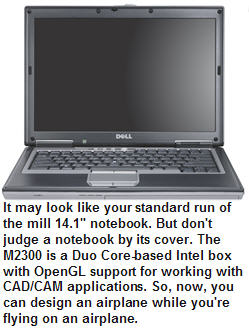Dell: The M2300 may look like a subnotebook, but it's certifiably a 'workstation'


You can hear my interview with Maynard and Spencer by pressing the play button in the Flash-based podcast player above. Alternatively, there's a download button if you want to manually bring it down to your system and play it later. Or, if you're subscribed to ZDNet's IT Matters series of podcasts (see how to subscribe), the MP3 file should turn up on your PC, your MP3 player or both (depending on how you have your podcatcher configured.
So what separates a 14.1" Dell Precision notebook from a 14.1" Dell Vostro or Dell Latitude notebook? The key differentiator, according to Maynard and Spencer is the notebook's built-in support for OpenGL-based graphics processing. Most engineering software in the CAD/CAM world performs significantly better on systems that support the OpenGL interface. Whereas desktop workstations can be modified to support OpenGL, adding aftermarket OpenGL support to a notebook is relatively impossible given how special chips from one of the major graphics outfits (ie: NVidia or ATI) are required. According to Spencer, the M2300 has NVidia's Quadro FX OpenGL supporting hardware soldered directly onto its motherboard.
Under the hood, customers can choose from four processors ranging from Intel's 2.00 GHz dual-core Core 2 Duo T7250 up to the 2.6 GHz T7800 and configure the system with anywhere from 1 to 4 GB of RAM. Buyers can also configure for hard drive storage ranging from80GB to 200GB. According to Maynard, Dell customers can choose to configure the M2300 with a variety of operating systems; the 32 and 64 bit versions of XP and Vista and, for the first time for Dell's mobile Precision workstations -- Red Hat Linux.
The M2300 represents the first time Dell is venturing into the 14.1-inch range with its workstation class notebooks. Maynard and Spencer say that this is positioned at engineers and engineering executives that won't necessarily be designing with the system -- but rather need something lightweight that they can take with them, but that can still support OpenGL. They say the M2300 weighs in at 5.4 lbs.
As you can hear in the podcast, the folks from Dell say that the starting price for the M2300 will be $1599. But a visit to Dell's Web site today shows a minimally configured M2300 costing $1915, no 64 bit options, no Red Hat Linux option, and no way to bring the price down to $1599 through reconfiguration (suggestion to Dell: make sure what you tell the press jives with what's on the Web site).
I've always found the designation "workstation" to be somewhat dubious. Average notebooks coming out in a couple of years may very well end up outperforming your so-called workstation of today. That's the nature of the business. In the podcast, Maynard and Spencer don't disagree and in fact say that it's for this very reason that the Precision notebook line is refereshed more frequently than other notebook lines. One interesting feature of the M2300 that you don't see on most notebooks; according to Spencer, it has a Smart Card reader built-into it.